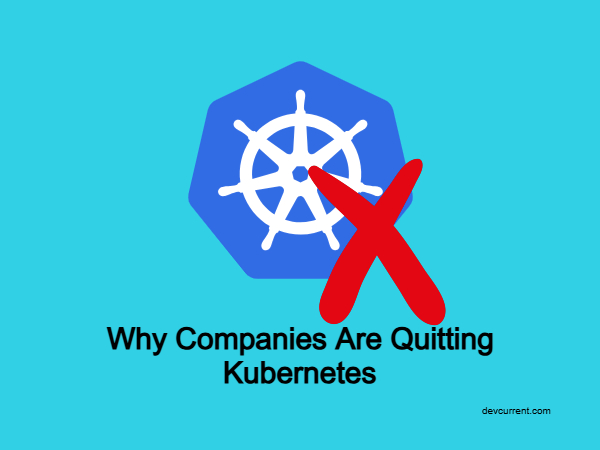Kubernetes has been a game-changer in the world of cloud computing, providing organizations with unparalleled capabilities for container orchestration. Its robust ecosystem has enabled businesses to deploy, manage, and scale their applications with ease. However, as Kubernetes adoption has grown, so too have the voices of companies choosing to step away from it.
The reasons for this trend are varied, ranging from the inherent complexity of Kubernetes to the rise of alternative technologies. In this blog, we’ll dive deep into the challenges companies face with Kubernetes, explore examples of businesses that have moved away, and discuss what this shift means for the future of cloud-native computing.
The Appeal of Kubernetes: A Double-Edged Sword
When Kubernetes was introduced by Google in 2014, it quickly became the standard for container orchestration. Its ability to automate deployment, scaling, and management of containerized applications revolutionized the software development lifecycle.
However, the very features that make Kubernetes powerful also make it challenging. While Kubernetes can efficiently handle complex, distributed systems, its flexibility often translates to a steep learning curve, significant operational overhead, and a high total cost of ownership (TCO).
Key Challenges with Kubernetes
1. Complexity
Managing Kubernetes is not for the faint of heart. Its architecture involves numerous components, including etcd, the API server, controllers, and schedulers. Setting up and maintaining clusters requires expertise in:
- Networking
- Security
- Observability
- Infrastructure as Code (IaC)
Many small and medium-sized businesses lack the skilled workforce required to operate Kubernetes effectively. Even for enterprises, managing Kubernetes can become a full-time job, detracting from the organization’s core mission.
2. Cost Overhead
Kubernetes is free and open-source, but running it isn’t. Costs can add up quickly, including:
- Infrastructure expenses for running clusters on cloud providers or on-premises hardware.
- Licensing costs for third-party tools like monitoring, logging, and security solutions.
- Staffing costs for hiring and retaining Kubernetes experts.
Many companies find that the ROI of Kubernetes doesn’t justify these expenses, especially for workloads that don’t require its advanced capabilities.
3. Developer Productivity
Kubernetes is often viewed as an “Ops-first” platform, designed with system administrators in mind rather than developers. Teams frequently struggle with:
- Writing and managing complex YAML files.
- Debugging issues across distributed systems.
- Setting up CI/CD pipelines tailored to Kubernetes.
This friction can lead to frustration, delayed deployments, and reduced innovation as developers focus on operational tasks instead of coding.
4. Security Risks
Kubernetes comes with its own set of security challenges. Misconfigurations are a leading cause of vulnerabilities, such as:
- Exposing sensitive data through improperly managed secrets.
- Misconfigured Role-Based Access Control (RBAC).
- Leaving the Kubernetes API server accessible to unauthorized users.
For organizations without a dedicated security team, these risks can be daunting and potentially disastrous.
5. Misalignment with Business Needs
Not every organization needs the power and flexibility of Kubernetes. For companies with simpler applications or less demanding workloads, Kubernetes can be overkill. Businesses are increasingly finding that alternative solutions—like Platform-as-a-Service (PaaS) offerings or serverless architectures—better align with their needs.
Also read about securing kubernetes ingress here
The Rise of Alternatives
The cloud-native landscape has evolved rapidly, offering a plethora of tools and platforms that address the pain points of Kubernetes. These include:
Serverless Computing
Platforms like AWS Lambda, Google Cloud Functions, and Azure Functions eliminate the need to manage infrastructure entirely. Developers can focus solely on writing code, while the platform handles scaling, deployment, and availability.
Managed Container Services
Services like AWS ECS Fargate and Azure Container Instances provide container orchestration without the complexity of Kubernetes. These platforms are ideal for smaller teams or simpler workloads.
PaaS Solutions
Heroku, Google App Engine, and similar platforms simplify application deployment, making them attractive to companies prioritizing ease of use and developer productivity.
Companies That Quit Kubernetes and Why

Basecamp: Simplifying Operations
Basecamp, known for its project management tools, decided to move away from Kubernetes because of its complexity. They found that their application didn’t require the scalability and flexibility Kubernetes offers. Instead, they reverted to simpler, self-managed infrastructure that allowed their team to focus on building features rather than maintaining Kubernetes clusters.
Zalando: Adopting Serverless for Simpler Workloads
Zalando, a European e-commerce leader, scaled back its Kubernetes usage for certain applications. While Kubernetes remains part of their infrastructure, they found that serverless solutions like AWS Lambda were more cost-effective and easier to manage for event-driven workloads.
Shopify: Prioritizing Developer Experience
Shopify, a leading e-commerce platform, initially embraced Kubernetes for its scalability but later moved some workloads back to traditional deployment methods. The company cited a mismatch between Kubernetes’ complexity and the simplicity required for their smaller services. They also highlighted the need for better developer productivity tools, which simpler platforms provided.
Dropbox: Custom Solutions for Specific Needs
Dropbox, a cloud storage giant, decided to move its machine learning workflows off Kubernetes. They found that Kubernetes’ flexibility came at the cost of slower development cycles. By building custom infrastructure optimized for their unique requirements, Dropbox was able to streamline its operations and improve efficiency.
Monzo: Cost and Operational Overhead
Monzo, a digital bank, scaled back its Kubernetes usage to address cost and operational challenges. While Kubernetes was initially chosen for its scalability, the company realized that maintaining Kubernetes clusters was draining resources that could be better spent on customer-facing initiatives.
Lessons Learned
The experiences of these companies reveal several key takeaways:
- One Size Doesn’t Fit All
Kubernetes is a powerful tool, but it’s not suitable for every workload. Companies must evaluate whether the complexity and cost of Kubernetes align with their specific needs. - Prioritize Simplicity
Simpler solutions often yield better results. By adopting alternatives like serverless platforms or managed container services, organizations can reduce operational overhead and focus on delivering value to customers. - Invest in Expertise
For businesses that choose Kubernetes, investing in skilled DevOps engineers and robust tooling is essential to mitigate its challenges. - Stay Agile
The technology landscape is constantly evolving. Companies should remain open to reevaluating their tech stack and adopting newer, more efficient solutions as they emerge.
The Future of Kubernetes
While some companies are quitting Kubernetes, it’s important to note that Kubernetes is far from obsolete. It remains the gold standard for container orchestration in complex, large-scale environments. However, its future lies in addressing the challenges that drive companies away.
Managed Kubernetes Services
Platforms like AWS EKS, Google Kubernetes Engine (GKE), and Azure Kubernetes Service (AKS) are making Kubernetes more accessible by abstracting away much of its complexity. These services handle tasks like cluster provisioning, upgrades, and scaling, enabling organizations to reap the benefits of Kubernetes without the operational burden.
Kubernetes Ecosystem Improvements
The Kubernetes community is actively working to improve usability. Tools like Helm, Kustomize, and GitOps frameworks are simplifying deployment and management, making Kubernetes more developer-friendly.
Specialized Use Cases
Kubernetes will continue to thrive in industries and applications that demand high scalability, resilience, and flexibility, such as:
- Media streaming platforms.
- Financial services with high transaction volumes.
- AI and machine learning workflows requiring distributed computing.
Conclusion
Kubernetes has transformed the way we think about application deployment and management. However, as with any technology, it’s not without its challenges. The decision to quit Kubernetes is not a reflection of its shortcomings but rather an acknowledgment that technology should serve the needs of the business, not the other way around.
For organizations evaluating their cloud strategy, the key question is not whether Kubernetes is good or bad—it’s whether Kubernetes is right for them. By understanding their unique requirements and staying informed about alternative solutions, companies can make the best choice for their future.
As the cloud-native ecosystem continues to evolve, one thing is certain: businesses will have more options than ever to build, deploy, and scale their applications. Kubernetes may not be the perfect fit for everyone, but it remains an essential part of the cloud-native journey.

